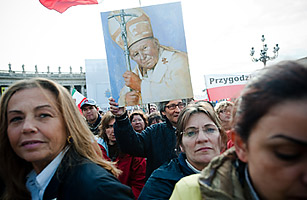
Even before the sun had risen, the crowd attending the beatification of Pope John Paul II had overfilled the square around the St. Peter’s basilica. By the time dawn broke, the faithful had spilled down the road towards the Tiber and into the side streets around the Vatican, where the ceremony — the first major milestone towards sainthood — was set to take place.
Many had spent the night, in tents or on blankets spread over the cobblestones. More than a million had risen early Sunday morning in order to join in the veneration of a larger-than-life Polish pope, who many felt had personally touched their lives. “I felt, when he was alive, that if I met him on the street, he would know my name,” said Danuta Kowalik, 36, a teacher who had driven from Poland for the occasion.
As the hour approached, the air above the crowd waved with flags: Mexican, Slovakian, French, Cuban, Lithuanian, but most of all Polish. “The entire world his here,” said one Ecuadorian pilgrim. Kowalik and her group of Polish Catholics had risen at 2 a.m. and driven through the dark in order to get to Rome on time. “In every gas station [on the three-day journey down through Italy], everybody was speaking Polish,” she said.
On the outskirts of the crowd, pilgrims sat down for picnics. Children tucked into biscuits and Nutella. An Italian priest led a group of worshipers through Ave Marias. Elizabeth Langenkamp, a 20-year-old sophomore at the Franciscan University in Steubenville in Ohio, had traveled from Austria, where she was studying for the semester at the university’s overseas branch. She had come to Rome with her class after the school had rescheduled the finals to allow for the trip. “It’s important to us and for the world to recognize the great man that he was,” she said.
Pilgrims held up their cameras as Pope Benedict XVI arrived by open-top popemobile and ascended to the altar. The timing makes John Paul’s beatification the fastest in modern times, initiated just days — instead of the customary years — after his death in 2005, from Parkinson’s disease, when millions gathered outside the Vatican to chant “Santo Subito” — “Sainthood Now.”
Though John Paul remains the most popular pontiff in recent times, and perhaps even church history, some have questioned the speed with which he is being moved towards sainthood — particularly in the light of his handling of the sex abuse crisis, which unfolded during his papacy. But few were in attendance Sunday. “If the Lord had not wanted him beatified now, he would not have granted the miracle,” said Carl Anderson, head of U.S.-based the Knights of Columbus, a Catholic lay organization. Before John Paul could be beatified, a miracle had to be attributed to him. In January, Benedict announced that the recovery of a French nun, who had lost her symptoms of Parkinson’s disease after praying to the late Pope, satisfied that condition.
On Sunday, the passion from the day of the funeral came close to repeating itself as Benedict pronounced the late Pope “blessed” and a curtain was lifted to reveal a tapestry with a portrait of John Paul in his prime, smiling at the height of his papacy. “He restored to Christianity its true face as a religion of hope,” said Benedict. As the ceremony came to a close, a vial of his blood — taken from a nearby hospital where it had been kept since his death — was presented, wrapped in a lattice work of silver olive leaves, as a relic to be venerated. His body, exhumed days earlier, lay in a casket inside the cathedral for the faithful to file past. “Look at the crowd today, so many young people,” said Anderson. “That’s why he’s being beatified now, so that more people would follow his example.”
Before John Paul can be canonized as a saint, the church will have to document one more miracle. But for many in attendance Sunday, the late pope’s sanctity is already beyond doubt. “It was through his agony, that we rediscovered God,” said Anne Elaine, 42, a French woman who says her family’s catholic faith was reawakened during John Paul’s final hours. Added her husband Xavier, 42: “It was his way of showing dignity in suffering.”
See the world’s most influential people in the 2011 TIME 100.
See TIME’s 140 best Twitter feeds.